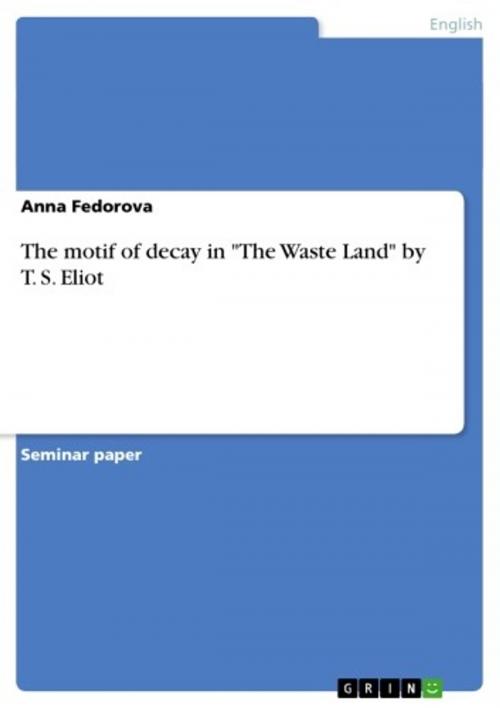The motif of decay in 'The Waste Land' by T. S. Eliot
Fiction & Literature, Literary Theory & Criticism, British| Author: | Anna Fedorova | ISBN: | 9783638871396 |
| Publisher: | GRIN Verlag | Publication: | December 5, 2007 |
| Imprint: | GRIN Verlag | Language: | English |
| Author: | Anna Fedorova |
| ISBN: | 9783638871396 |
| Publisher: | GRIN Verlag |
| Publication: | December 5, 2007 |
| Imprint: | GRIN Verlag |
| Language: | English |
Seminar paper from the year 2004 in the subject English Language and Literature Studies - Literature, grade: 2,0, University of Hannover (Englisches Seminar), course: High Modernism, 7 entries in the bibliography, language: English, abstract: In the epigraph to The Waste Land the Sybil, a woman with prophetic abilities, looks at the future and proclaims that the only thing she wants is to die. Her pessimism about the future is the first indication of the idea which develops into the central theme of the poem: the decay of the human civilization. In this paper I am going to concentrate on interpretation of the motif of decay and its meanings in The Waste Land. The poem was published in 1922 and appears to be a typical literary example of Modern poetry. That's why I decided to adopt the New Critical perspective for my paper. [...] Since the New Critical approach implies the close reading of the text, I am going to work, for the most part, with the text itself (rather than with secondary sources) and go through the parts of the poem, pursuing three following issues: •to describe the main themes, which are raised in the five sections of the poem, and show how they contribute to the motif of decay and to the complexity of the poem. •to look at different levels of the text, searching for ambiguities and trying to resolve them. •to describe main literary devises which are used in the poem ( symbols, images, metaphors, irony, paradox and s.o.) and to show how the author's techniques contribute to the theme of decay.
Seminar paper from the year 2004 in the subject English Language and Literature Studies - Literature, grade: 2,0, University of Hannover (Englisches Seminar), course: High Modernism, 7 entries in the bibliography, language: English, abstract: In the epigraph to The Waste Land the Sybil, a woman with prophetic abilities, looks at the future and proclaims that the only thing she wants is to die. Her pessimism about the future is the first indication of the idea which develops into the central theme of the poem: the decay of the human civilization. In this paper I am going to concentrate on interpretation of the motif of decay and its meanings in The Waste Land. The poem was published in 1922 and appears to be a typical literary example of Modern poetry. That's why I decided to adopt the New Critical perspective for my paper. [...] Since the New Critical approach implies the close reading of the text, I am going to work, for the most part, with the text itself (rather than with secondary sources) and go through the parts of the poem, pursuing three following issues: •to describe the main themes, which are raised in the five sections of the poem, and show how they contribute to the motif of decay and to the complexity of the poem. •to look at different levels of the text, searching for ambiguities and trying to resolve them. •to describe main literary devises which are used in the poem ( symbols, images, metaphors, irony, paradox and s.o.) and to show how the author's techniques contribute to the theme of decay.















